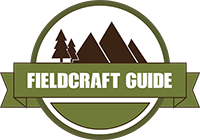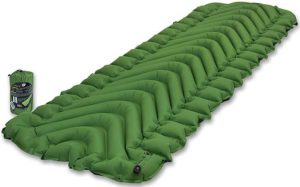Tips for Sleeping Outside without a Tent

One thing I have had lots of experience with over the years in the Army is sleeping outside without a tent. Most of the time tents are too cumbersome, or we don’t have an efficient way to transport them.
Another disadvantage of sleeping in a tent, is how it reduces situational awareness. If someone attacks you at night, you have to fight your way out of the tent before you can begin engaging. I have learned a few tricks to sleeping outside without a tent when on a field exercise in the desert or woods. Or if you are simply looking for some tips for your next camping or backpacking trip this post has something for you as well.
One thing I have had lots of experience with over the years in the Army is sleeping outside without a tent. Most of the time tents are too cumbersome, or we don’t have an efficient way to transport them.
Another disadvantage of sleeping in a tent, is how it reduces your situational awareness. If someone attacks you at night, you have to fight your way out of the tent before you can begin engaging.
I have learned a few tricks to sleeping outside without a tent when on a field exercise in the desert or woods. Or if you are simply looking for some tips for your next camping or backpacking trip this post has something for you as well.
16 Tips to Select a Great Spot to Sleep without a Tent
#1 Select an area at least 200 feet from a water source.
Areas within 200 feet have more than average insects, large animals coming down to drink, and above average condensation on your hooch or sleeping bag.
On the flip side, you want to be close enough to water that you can can refill canteens, bathe, and wash dishes and clothes as needed.
#2 Select an area away from roads and railroad tracks.
Vehicles may travel down the road in the middle of the night disturbing your sleep, or could veer off the road and run you over!
#3 Obey regulations for the trail or wilderness area.
You can usually look up the trail or area on the internet prior to your trip and determine if they have any regulations that will govern your campsite selection.
#4 Don’t camp next to others unless you know them, are invited, or regulations insist you use one area.
Other Soldiers/campers can see this as creepy, and they may wake at 0400 to get an early start, and you weren’t planning to wake until 0700.
#5 Avoid areas in low spots that can flood if a dam releases water, or if it begins to rain.
You can also identify these spots on a topographic map as an intermittent stream bed.
Also between two hills in a lower spot can collect a lot of runoff from the two hills.
#6 Try to get setup during daylight hours.
Everything is harder when it gets dark, including setting up your site, collecting water or firewood, and checking your site for safety hazards (cliffs, cacti, etc).
I typically allow 1-2 hours to setup before sunset.
#7 If you are setting up a hammock ensure there are good trees available.
The right spacing of trees and proper girth of trees are essential if hammock camping.
#8 Find a spot with a windbreak if possible.
If it is windy and you do not have a windbreak your tarp/bivvy is going to sound like a freight train inside as it flaps in the wind.
Look for some brush or a hill to camp next to in order to help shield yourself from nature.
#9 Check for poisonous plants around your proposed area.
Poison Ivy, Oak, and Sumac can really put a damper on your trip. Oak and Ivy are easily identifiable with “Leaves of three let them be”. Avoid it at all costs!
#10 Select a level spot to sleep if available.
No one likes the fear of rolling down a hill while you sleep. Also, it can cause you to wake up with a stuffy nose if your head is downslope of the rest of your body.
#11 Clear the ground of any sharp rocks, sticks, or vegetation.
They can cut your sleeping bag or ground cloth as well as poke you while you sleep.
#12 Before investing too much time in your site, look for “widow makers”
These are branches that are dead or look like they may fall on you if the wind picks up.
#13 Use a tarp or other ground cloth.
This will prevent some of the condensation from forming on your sleeping bag as the dew falls. It also keeps the bottom of your sleeping bag clean. It is much easier to clean a tarp in a creek than it is to clean your sleeping bag.
#14 Dig a shallow drainage ditch on the uphill slope of your spot.
This will help any rain runoff move around your sleeping bag.
#15 If your site is a little muddy, place some dead leaves where you will set your sleeping bag.
This will also make it softer to lay on. Pine straw also works, just don’t use poison sumac or poison ivy leaves!
#16 Leave a light on if you have to leave at night.
If you leave your area in the dark, leave a light on in the area to help you find it easily again when you are finished with whatever business you are doing.
5 Tips to Keep Animals Out of your Sleep Area
- Never eat in your sleeping bag. Crumbs will inevitably fall onto the floor, and animals in the wild can smell very long distances. they will be attracted to your bag while you sleep. This could be as simple as mice, raccoons, squirrels, or as big as a bear. Eat food away from where you plan to sleep!
- Even during the day don’t leave open food lying around. Birds and squirrels can swoop in in the blink of an eye and snatch it up.
- If you are in bear country with trees you can hoist it into a tree. You want it 10-15 feet from the ground and at least 4 feet from the trunk of the tree.
- If no trees are available you can use either a bear locker (if one is available close to your campsite) or you can bring a bear proof container or bear bag. The only issue with this is they are rather bulky and heavy.
- Wash your dishes at least 100 feet from your area. Food from your dishes will also attract animals into your site.
The Gear you Need for Sleeping Outside without a Tent
#1 Sleeping Pads: I always take a sleeping pad with me when sleeping in a tent or on the ground without a tent.
They can add great comfort, and in cooler weather help keep your body off the cold ground. There are two main types: Foam and Inflatable.
I have used both and prefer the inflatable types for their small size and low weight. Also they are more comfortable.
One benefit to foam pads is that they can be rolled and strapped outside your pack, and can be easily removed for a place to sit when stopping for short breaks on the trail.
Foam pads also keep you warmer, as the air in the inflatable pad can suck body heat away.
I use the Klymit Static V Lightweight Sleeping Pad. It is an inflatable pad. It is a 72″ x 23″ so it is about 3 inches wider than most sleep pads. I can inflate it in about 8 breaths. The V shape of the baffles keeps me from sinking to the bottom, and distributes my weight evenly.
I am 5’10” and weigh about 200 lbs., and this pad works great for me. I have had it for several years with no punctures and have used it while sleeping on steel tanks, in the back of trucks, on sand, rocks, cots, in the woods, and it never disappoints. You can check it out on Amazon here.
#2 Why Use a Sleeping Bag Liner? There are several reasons I always use a bag liner.
The first one is because it is like sheets for your bed. I can sweat, get it a little muddy, whatever the case is, and when it needs to be washed I can easily wash it with some soap and water and it will be dry in a few hours.
Secondly, they feel awesome! The one I use feels like a well worn, washed t-shirt. Much more comfortable than the nylon/polyester feeling material of my army sleeping bag, and it doesn’t stick to me like a lot of those technical fabrics tend to do.
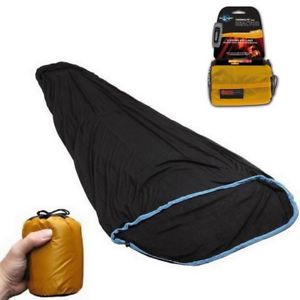
Third, it can add a few degrees to my sleeping bag for when it gets cold.
Lastly, if its hot outside I will just use the liner as a bag and not use the rest of my sleeping bag.
I have the Sea To Summit Reactor Thermolite Sleeping Bag Liner. It is mummy shaped with a hood. 100% polyester, but feels like a t-shirt. Provides up to 14 degrees extra warmth. Click here to check latest prices on Amazon.
3 Do I really need a pillow?
You can call me a princess if you want, but laying my face on stinky clothes while I try to sleep is not something I find comfortable.
Even stuffing them in a stuff sack I find myself waking up in the middle of the night with my face on the ground in a spot where I have nestled my way through the clothes.
In a pinch I can use whatever I have to, but I prefer a pillow.
I am a side sleeper, so I prefer a firmer pillow with some height to it. Which is why I prefer an inflatable pillow.
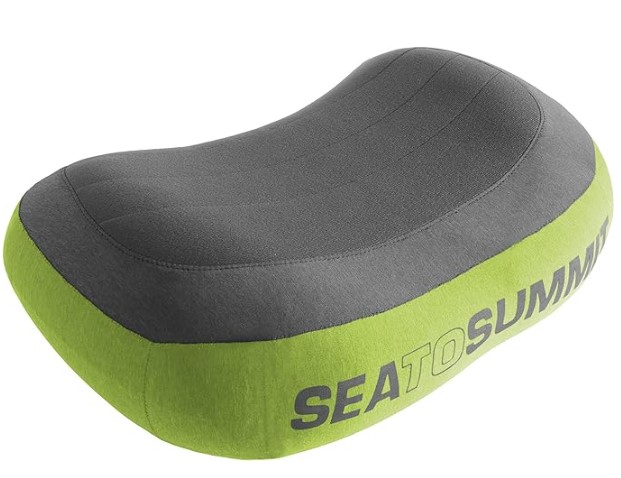
I can adjust the amount of air in the pillow to find just the right combination of softness and height to take the pressure off my shoulder. I am currently using the Sea to Summit Aeros pillow.
It has a small layer of fabric where you put your face, doesn’t move around during the night, and doesn’t make a lot of noise when I move. This pillow is still very comfy if you are a back sleeper if you adjust the air to make it softer. Click here to see it on Amazon.
The other option for backpacking or field pillows would be a compressible pillow.
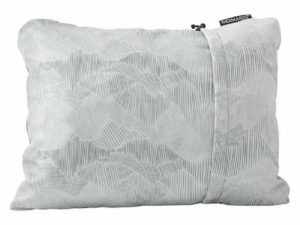
Several of my battle buddies use a smaller down or poly filled pillow. These weigh a little more than an inflatable, and do not offer as much comfort for side sleepers, but they swear by them.
These are especially good if you sleep on your back or stomach. The most popular one right no is the Therma-a-rest Compressible Travel Pillow. It has a polyester fill, and comes in a variety of sizes and weights. Check it out here.
#4 Bivy Sack for Sleeping Outside without a Tent
I have slept outside without a tent in the training areas around Ft Drum, NY in winter and the bevy sack saved me.
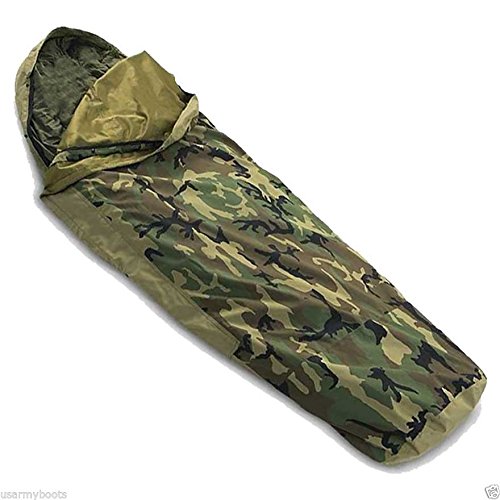
I woke up in the morning covered with 6 inches of snow, and had no idea while I was asleep.
It kept me dry and warm even under snow.
You can check them out at Amazon, click here.
The only thing I would say is that if it is raining you will get wet, the runoff will run into the top of your bivy and get you wet.
The only key to not getting wet would be to dig a ditch around your sleep area, to prevent getting too wet.
#5 Additional sleeping gear tips for a good night’s sleep in the great outdoors
Keep sleeping bag rolled up until ready to use it. This keeps it warmer, and keeps the critters out of it. In the morning leave it open and unzipped to allow it to air out.
Place some dryer sheets in the bottom of your bag to help keep it smelling fresh.
If your clothes are damp (not dripping wet) place them in your bag with you. Your body will generate a lot of heat and can dry damp clothes overnight. You can also put your next days clothes in their with you so they are not freezing cold the next morning when you got o put them on.
Boil some water on your camp stove and put it into a Nalgene water bottle or canteen and put that in the bottom of your bag before going to bed to warm it up. It will last a few hours.
If your sleeping pad will fit in your bag with you, this can aid in not sliding off of it during the night. Some bags have a special pocket for sleeping pads.
Below are some general tips I have used to help me sleep in the field.
- Eat a meal before bed. If you have food in your stomach you will be warmer and it will help you fall asleep faster.
- Urinate before bed. This may prevent you from having to get up at 1 AM to go relieve yourself. NOTE: For an internal alarm clock you can drink a good amount and it will wake you up, depending on your bladder holding capacity (mine wakes me in about 5 hours).
- Use earplugs to block out bugs from buzzing in your ears, or from nature sounds, wind blowing your tent. Sometimes its good to not have them in, like if a bear is nosing through your pack.
- If sleeping on an incline put head toward incline and prop your feet up with a pack. You can also lie sideways on the incline and put your pack on the downhill slope for a backstop. Whatever is more comfortable.
- Wear a beanie hat to prevent bugs in ears, cover your eyes, and keep your head warm.
- Keep a light close by, and your firearm if you have one. You never know when you will get woke up by a thief, bear, snake, or other.
- Use a carabiner to hang your pack off the ground. This will help it dry out if sweat through, and make it harder for critters to eat that snickers bar.
- Use a bear bag hoisted into a tree (not over your sleeping bag) to prevent critters and bears from eating all your chow.
In Conclusion…
I have tried to capture some important points in this post for how to sleep outside without a tent. Did I miss some? Leave a comment below, and I will add it to the post above!
